Marketing Intelligence Report: M&S Market Research and Strategy
VerifiedAdded on 2020/10/05
|19
|6969
|399
Report
AI Summary
This report provides a detailed analysis of Marks & Spencer's (M&S) marketing intelligence. It begins by outlining the main stages of the consumer purchase decision-making process, including problem recognition, information search, evaluation of alternatives, purchase decision, and post-purchase behavior. The report then delves into consumer behavior theories, examining factors influencing buyer behavior such as personality, purchasing power, and the stimulus-response model. It further explores sociological, economic, and cultural factors that affect consumer decisions. The analysis extends to the relationship between corporate image, repeat purchasing, and brand loyalty, highlighting their interconnectedness. The report also covers various marketing research techniques, secondary data sources, and the importance of reliability and validity in market research findings. It includes a discussion on market size trends, competitor analysis, and the identification of threats and opportunities. Finally, the report examines techniques for assessing consumer response, the design of consumer satisfaction surveys, and the evaluation of survey success. The report concludes with a summary of the key findings and recommendations for M&S's marketing strategies.
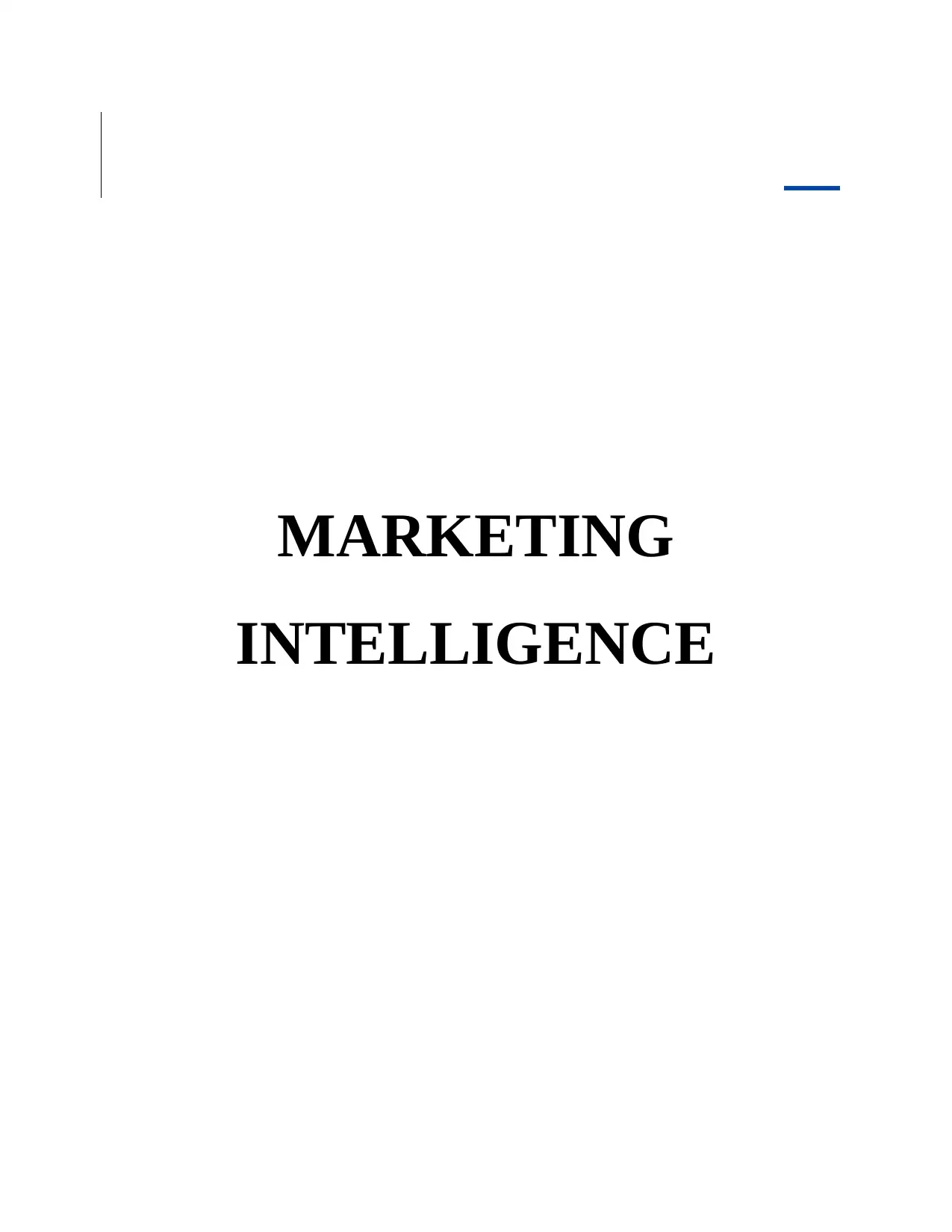
MARKETING
INTELLIGENCE
INTELLIGENCE
Paraphrase This Document
Need a fresh take? Get an instant paraphrase of this document with our AI Paraphraser
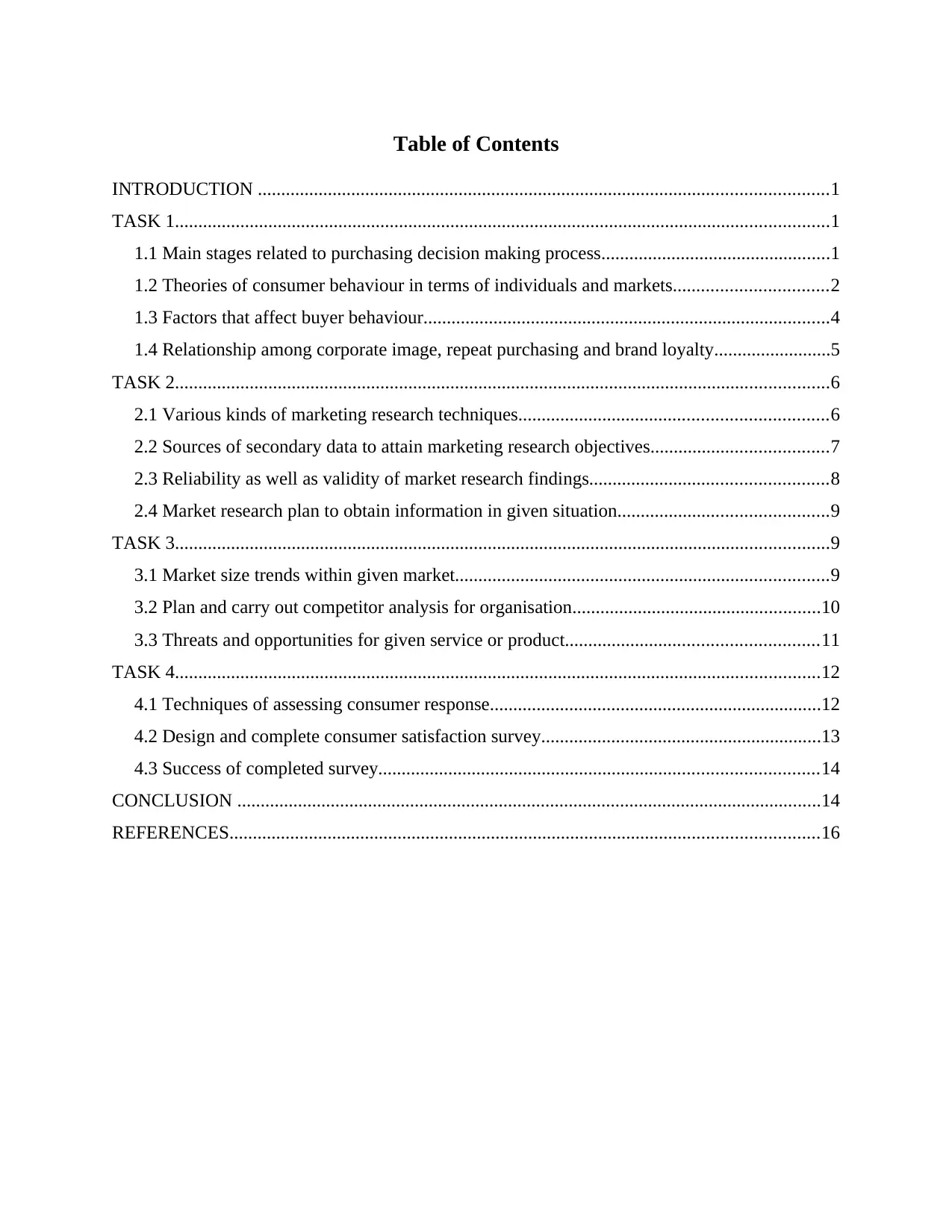
Table of Contents
INTRODUCTION ..........................................................................................................................1
TASK 1............................................................................................................................................1
1.1 Main stages related to purchasing decision making process.................................................1
1.2 Theories of consumer behaviour in terms of individuals and markets.................................2
1.3 Factors that affect buyer behaviour.......................................................................................4
1.4 Relationship among corporate image, repeat purchasing and brand loyalty.........................5
TASK 2............................................................................................................................................6
2.1 Various kinds of marketing research techniques..................................................................6
2.2 Sources of secondary data to attain marketing research objectives......................................7
2.3 Reliability as well as validity of market research findings...................................................8
2.4 Market research plan to obtain information in given situation.............................................9
TASK 3............................................................................................................................................9
3.1 Market size trends within given market................................................................................9
3.2 Plan and carry out competitor analysis for organisation.....................................................10
3.3 Threats and opportunities for given service or product......................................................11
TASK 4..........................................................................................................................................12
4.1 Techniques of assessing consumer response.......................................................................12
4.2 Design and complete consumer satisfaction survey............................................................13
4.3 Success of completed survey..............................................................................................14
CONCLUSION .............................................................................................................................14
REFERENCES..............................................................................................................................16
INTRODUCTION ..........................................................................................................................1
TASK 1............................................................................................................................................1
1.1 Main stages related to purchasing decision making process.................................................1
1.2 Theories of consumer behaviour in terms of individuals and markets.................................2
1.3 Factors that affect buyer behaviour.......................................................................................4
1.4 Relationship among corporate image, repeat purchasing and brand loyalty.........................5
TASK 2............................................................................................................................................6
2.1 Various kinds of marketing research techniques..................................................................6
2.2 Sources of secondary data to attain marketing research objectives......................................7
2.3 Reliability as well as validity of market research findings...................................................8
2.4 Market research plan to obtain information in given situation.............................................9
TASK 3............................................................................................................................................9
3.1 Market size trends within given market................................................................................9
3.2 Plan and carry out competitor analysis for organisation.....................................................10
3.3 Threats and opportunities for given service or product......................................................11
TASK 4..........................................................................................................................................12
4.1 Techniques of assessing consumer response.......................................................................12
4.2 Design and complete consumer satisfaction survey............................................................13
4.3 Success of completed survey..............................................................................................14
CONCLUSION .............................................................................................................................14
REFERENCES..............................................................................................................................16
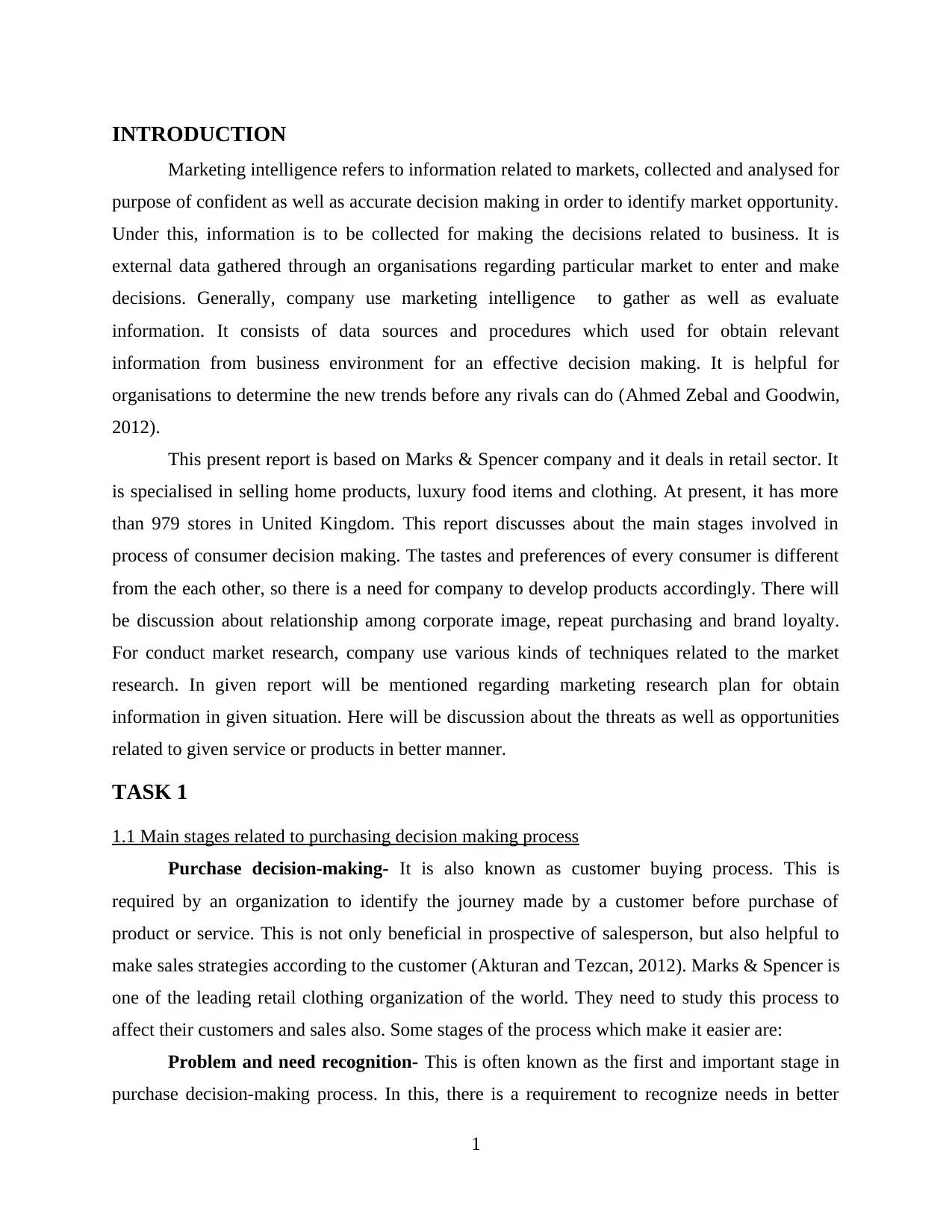
INTRODUCTION
Marketing intelligence refers to information related to markets, collected and analysed for
purpose of confident as well as accurate decision making in order to identify market opportunity.
Under this, information is to be collected for making the decisions related to business. It is
external data gathered through an organisations regarding particular market to enter and make
decisions. Generally, company use marketing intelligence to gather as well as evaluate
information. It consists of data sources and procedures which used for obtain relevant
information from business environment for an effective decision making. It is helpful for
organisations to determine the new trends before any rivals can do (Ahmed Zebal and Goodwin,
2012).
This present report is based on Marks & Spencer company and it deals in retail sector. It
is specialised in selling home products, luxury food items and clothing. At present, it has more
than 979 stores in United Kingdom. This report discusses about the main stages involved in
process of consumer decision making. The tastes and preferences of every consumer is different
from the each other, so there is a need for company to develop products accordingly. There will
be discussion about relationship among corporate image, repeat purchasing and brand loyalty.
For conduct market research, company use various kinds of techniques related to the market
research. In given report will be mentioned regarding marketing research plan for obtain
information in given situation. Here will be discussion about the threats as well as opportunities
related to given service or products in better manner.
TASK 1
1.1 Main stages related to purchasing decision making process
Purchase decision-making- It is also known as customer buying process. This is
required by an organization to identify the journey made by a customer before purchase of
product or service. This is not only beneficial in prospective of salesperson, but also helpful to
make sales strategies according to the customer (Akturan and Tezcan, 2012). Marks & Spencer is
one of the leading retail clothing organization of the world. They need to study this process to
affect their customers and sales also. Some stages of the process which make it easier are:
Problem and need recognition- This is often known as the first and important stage in
purchase decision-making process. In this, there is a requirement to recognize needs in better
1
Marketing intelligence refers to information related to markets, collected and analysed for
purpose of confident as well as accurate decision making in order to identify market opportunity.
Under this, information is to be collected for making the decisions related to business. It is
external data gathered through an organisations regarding particular market to enter and make
decisions. Generally, company use marketing intelligence to gather as well as evaluate
information. It consists of data sources and procedures which used for obtain relevant
information from business environment for an effective decision making. It is helpful for
organisations to determine the new trends before any rivals can do (Ahmed Zebal and Goodwin,
2012).
This present report is based on Marks & Spencer company and it deals in retail sector. It
is specialised in selling home products, luxury food items and clothing. At present, it has more
than 979 stores in United Kingdom. This report discusses about the main stages involved in
process of consumer decision making. The tastes and preferences of every consumer is different
from the each other, so there is a need for company to develop products accordingly. There will
be discussion about relationship among corporate image, repeat purchasing and brand loyalty.
For conduct market research, company use various kinds of techniques related to the market
research. In given report will be mentioned regarding marketing research plan for obtain
information in given situation. Here will be discussion about the threats as well as opportunities
related to given service or products in better manner.
TASK 1
1.1 Main stages related to purchasing decision making process
Purchase decision-making- It is also known as customer buying process. This is
required by an organization to identify the journey made by a customer before purchase of
product or service. This is not only beneficial in prospective of salesperson, but also helpful to
make sales strategies according to the customer (Akturan and Tezcan, 2012). Marks & Spencer is
one of the leading retail clothing organization of the world. They need to study this process to
affect their customers and sales also. Some stages of the process which make it easier are:
Problem and need recognition- This is often known as the first and important stage in
purchase decision-making process. In this, there is a requirement to recognize needs in better
1
⊘ This is a preview!⊘
Do you want full access?
Subscribe today to unlock all pages.

Trusted by 1+ million students worldwide
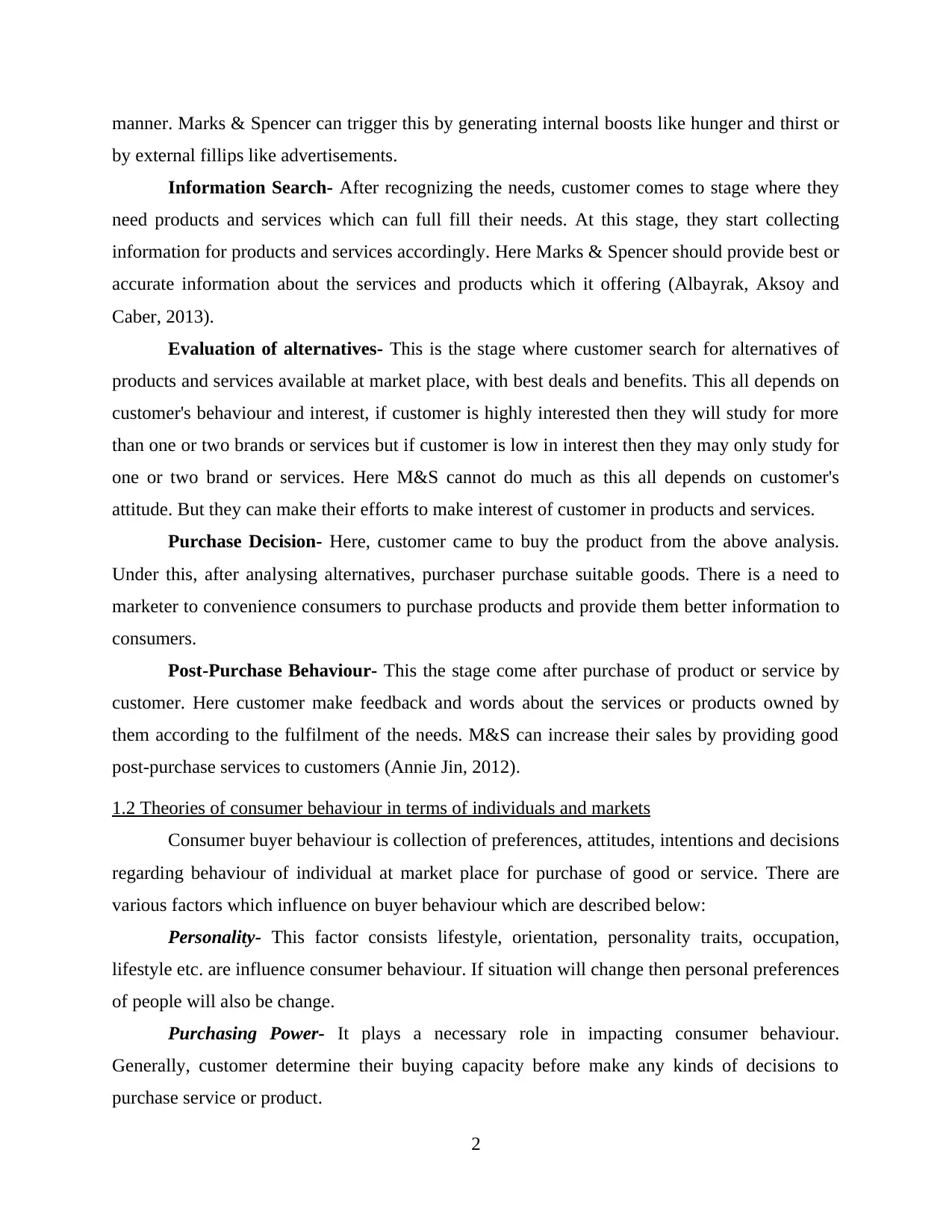
manner. Marks & Spencer can trigger this by generating internal boosts like hunger and thirst or
by external fillips like advertisements.
Information Search- After recognizing the needs, customer comes to stage where they
need products and services which can full fill their needs. At this stage, they start collecting
information for products and services accordingly. Here Marks & Spencer should provide best or
accurate information about the services and products which it offering (Albayrak, Aksoy and
Caber, 2013).
Evaluation of alternatives- This is the stage where customer search for alternatives of
products and services available at market place, with best deals and benefits. This all depends on
customer's behaviour and interest, if customer is highly interested then they will study for more
than one or two brands or services but if customer is low in interest then they may only study for
one or two brand or services. Here M&S cannot do much as this all depends on customer's
attitude. But they can make their efforts to make interest of customer in products and services.
Purchase Decision- Here, customer came to buy the product from the above analysis.
Under this, after analysing alternatives, purchaser purchase suitable goods. There is a need to
marketer to convenience consumers to purchase products and provide them better information to
consumers.
Post-Purchase Behaviour- This the stage come after purchase of product or service by
customer. Here customer make feedback and words about the services or products owned by
them according to the fulfilment of the needs. M&S can increase their sales by providing good
post-purchase services to customers (Annie Jin, 2012).
1.2 Theories of consumer behaviour in terms of individuals and markets
Consumer buyer behaviour is collection of preferences, attitudes, intentions and decisions
regarding behaviour of individual at market place for purchase of good or service. There are
various factors which influence on buyer behaviour which are described below:
Personality- This factor consists lifestyle, orientation, personality traits, occupation,
lifestyle etc. are influence consumer behaviour. If situation will change then personal preferences
of people will also be change.
Purchasing Power- It plays a necessary role in impacting consumer behaviour.
Generally, customer determine their buying capacity before make any kinds of decisions to
purchase service or product.
2
by external fillips like advertisements.
Information Search- After recognizing the needs, customer comes to stage where they
need products and services which can full fill their needs. At this stage, they start collecting
information for products and services accordingly. Here Marks & Spencer should provide best or
accurate information about the services and products which it offering (Albayrak, Aksoy and
Caber, 2013).
Evaluation of alternatives- This is the stage where customer search for alternatives of
products and services available at market place, with best deals and benefits. This all depends on
customer's behaviour and interest, if customer is highly interested then they will study for more
than one or two brands or services but if customer is low in interest then they may only study for
one or two brand or services. Here M&S cannot do much as this all depends on customer's
attitude. But they can make their efforts to make interest of customer in products and services.
Purchase Decision- Here, customer came to buy the product from the above analysis.
Under this, after analysing alternatives, purchaser purchase suitable goods. There is a need to
marketer to convenience consumers to purchase products and provide them better information to
consumers.
Post-Purchase Behaviour- This the stage come after purchase of product or service by
customer. Here customer make feedback and words about the services or products owned by
them according to the fulfilment of the needs. M&S can increase their sales by providing good
post-purchase services to customers (Annie Jin, 2012).
1.2 Theories of consumer behaviour in terms of individuals and markets
Consumer buyer behaviour is collection of preferences, attitudes, intentions and decisions
regarding behaviour of individual at market place for purchase of good or service. There are
various factors which influence on buyer behaviour which are described below:
Personality- This factor consists lifestyle, orientation, personality traits, occupation,
lifestyle etc. are influence consumer behaviour. If situation will change then personal preferences
of people will also be change.
Purchasing Power- It plays a necessary role in impacting consumer behaviour.
Generally, customer determine their buying capacity before make any kinds of decisions to
purchase service or product.
2
Paraphrase This Document
Need a fresh take? Get an instant paraphrase of this document with our AI Paraphraser
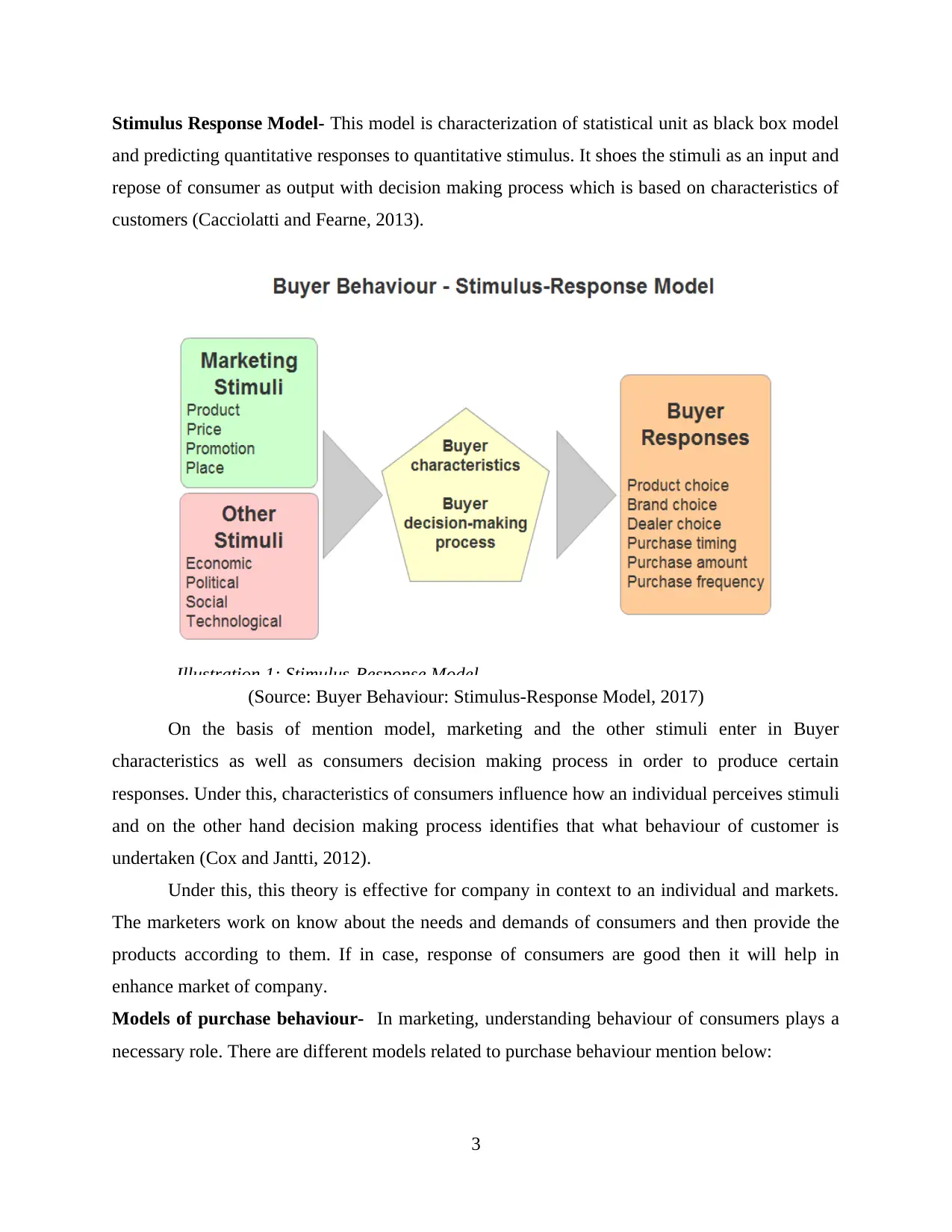
Stimulus Response Model- This model is characterization of statistical unit as black box model
and predicting quantitative responses to quantitative stimulus. It shoes the stimuli as an input and
repose of consumer as output with decision making process which is based on characteristics of
customers (Cacciolatti and Fearne, 2013).
(Source: Buyer Behaviour: Stimulus-Response Model, 2017)
On the basis of mention model, marketing and the other stimuli enter in Buyer
characteristics as well as consumers decision making process in order to produce certain
responses. Under this, characteristics of consumers influence how an individual perceives stimuli
and on the other hand decision making process identifies that what behaviour of customer is
undertaken (Cox and Jantti, 2012).
Under this, this theory is effective for company in context to an individual and markets.
The marketers work on know about the needs and demands of consumers and then provide the
products according to them. If in case, response of consumers are good then it will help in
enhance market of company.
Models of purchase behaviour- In marketing, understanding behaviour of consumers plays a
necessary role. There are different models related to purchase behaviour mention below:
3
Illustration 1: Stimulus-Response Model
and predicting quantitative responses to quantitative stimulus. It shoes the stimuli as an input and
repose of consumer as output with decision making process which is based on characteristics of
customers (Cacciolatti and Fearne, 2013).
(Source: Buyer Behaviour: Stimulus-Response Model, 2017)
On the basis of mention model, marketing and the other stimuli enter in Buyer
characteristics as well as consumers decision making process in order to produce certain
responses. Under this, characteristics of consumers influence how an individual perceives stimuli
and on the other hand decision making process identifies that what behaviour of customer is
undertaken (Cox and Jantti, 2012).
Under this, this theory is effective for company in context to an individual and markets.
The marketers work on know about the needs and demands of consumers and then provide the
products according to them. If in case, response of consumers are good then it will help in
enhance market of company.
Models of purchase behaviour- In marketing, understanding behaviour of consumers plays a
necessary role. There are different models related to purchase behaviour mention below:
3
Illustration 1: Stimulus-Response Model
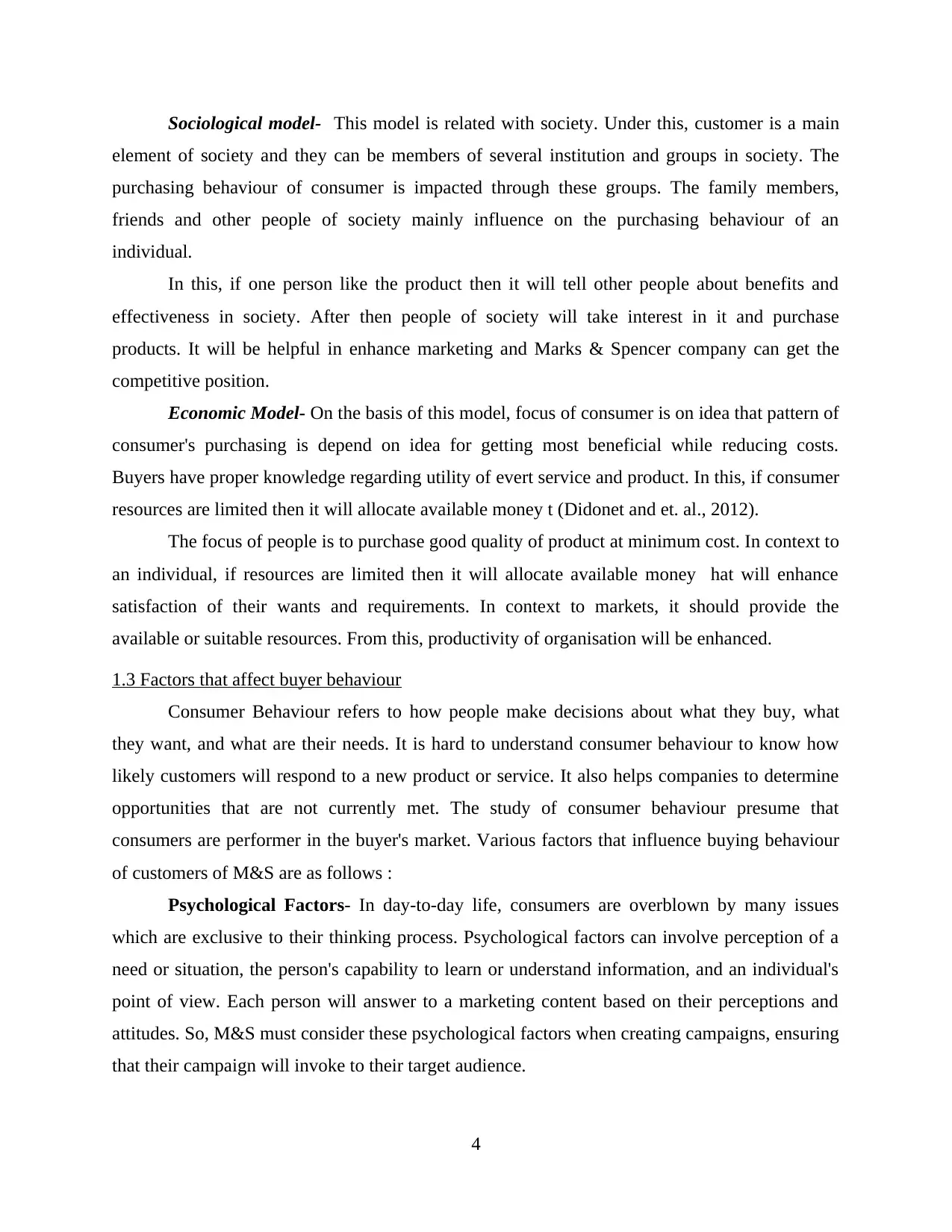
Sociological model- This model is related with society. Under this, customer is a main
element of society and they can be members of several institution and groups in society. The
purchasing behaviour of consumer is impacted through these groups. The family members,
friends and other people of society mainly influence on the purchasing behaviour of an
individual.
In this, if one person like the product then it will tell other people about benefits and
effectiveness in society. After then people of society will take interest in it and purchase
products. It will be helpful in enhance marketing and Marks & Spencer company can get the
competitive position.
Economic Model- On the basis of this model, focus of consumer is on idea that pattern of
consumer's purchasing is depend on idea for getting most beneficial while reducing costs.
Buyers have proper knowledge regarding utility of evert service and product. In this, if consumer
resources are limited then it will allocate available money t (Didonet and et. al., 2012).
The focus of people is to purchase good quality of product at minimum cost. In context to
an individual, if resources are limited then it will allocate available money hat will enhance
satisfaction of their wants and requirements. In context to markets, it should provide the
available or suitable resources. From this, productivity of organisation will be enhanced.
1.3 Factors that affect buyer behaviour
Consumer Behaviour refers to how people make decisions about what they buy, what
they want, and what are their needs. It is hard to understand consumer behaviour to know how
likely customers will respond to a new product or service. It also helps companies to determine
opportunities that are not currently met. The study of consumer behaviour presume that
consumers are performer in the buyer's market. Various factors that influence buying behaviour
of customers of M&S are as follows :
Psychological Factors- In day-to-day life, consumers are overblown by many issues
which are exclusive to their thinking process. Psychological factors can involve perception of a
need or situation, the person's capability to learn or understand information, and an individual's
point of view. Each person will answer to a marketing content based on their perceptions and
attitudes. So, M&S must consider these psychological factors when creating campaigns, ensuring
that their campaign will invoke to their target audience.
4
element of society and they can be members of several institution and groups in society. The
purchasing behaviour of consumer is impacted through these groups. The family members,
friends and other people of society mainly influence on the purchasing behaviour of an
individual.
In this, if one person like the product then it will tell other people about benefits and
effectiveness in society. After then people of society will take interest in it and purchase
products. It will be helpful in enhance marketing and Marks & Spencer company can get the
competitive position.
Economic Model- On the basis of this model, focus of consumer is on idea that pattern of
consumer's purchasing is depend on idea for getting most beneficial while reducing costs.
Buyers have proper knowledge regarding utility of evert service and product. In this, if consumer
resources are limited then it will allocate available money t (Didonet and et. al., 2012).
The focus of people is to purchase good quality of product at minimum cost. In context to
an individual, if resources are limited then it will allocate available money hat will enhance
satisfaction of their wants and requirements. In context to markets, it should provide the
available or suitable resources. From this, productivity of organisation will be enhanced.
1.3 Factors that affect buyer behaviour
Consumer Behaviour refers to how people make decisions about what they buy, what
they want, and what are their needs. It is hard to understand consumer behaviour to know how
likely customers will respond to a new product or service. It also helps companies to determine
opportunities that are not currently met. The study of consumer behaviour presume that
consumers are performer in the buyer's market. Various factors that influence buying behaviour
of customers of M&S are as follows :
Psychological Factors- In day-to-day life, consumers are overblown by many issues
which are exclusive to their thinking process. Psychological factors can involve perception of a
need or situation, the person's capability to learn or understand information, and an individual's
point of view. Each person will answer to a marketing content based on their perceptions and
attitudes. So, M&S must consider these psychological factors when creating campaigns, ensuring
that their campaign will invoke to their target audience.
4
⊘ This is a preview!⊘
Do you want full access?
Subscribe today to unlock all pages.

Trusted by 1+ million students worldwide
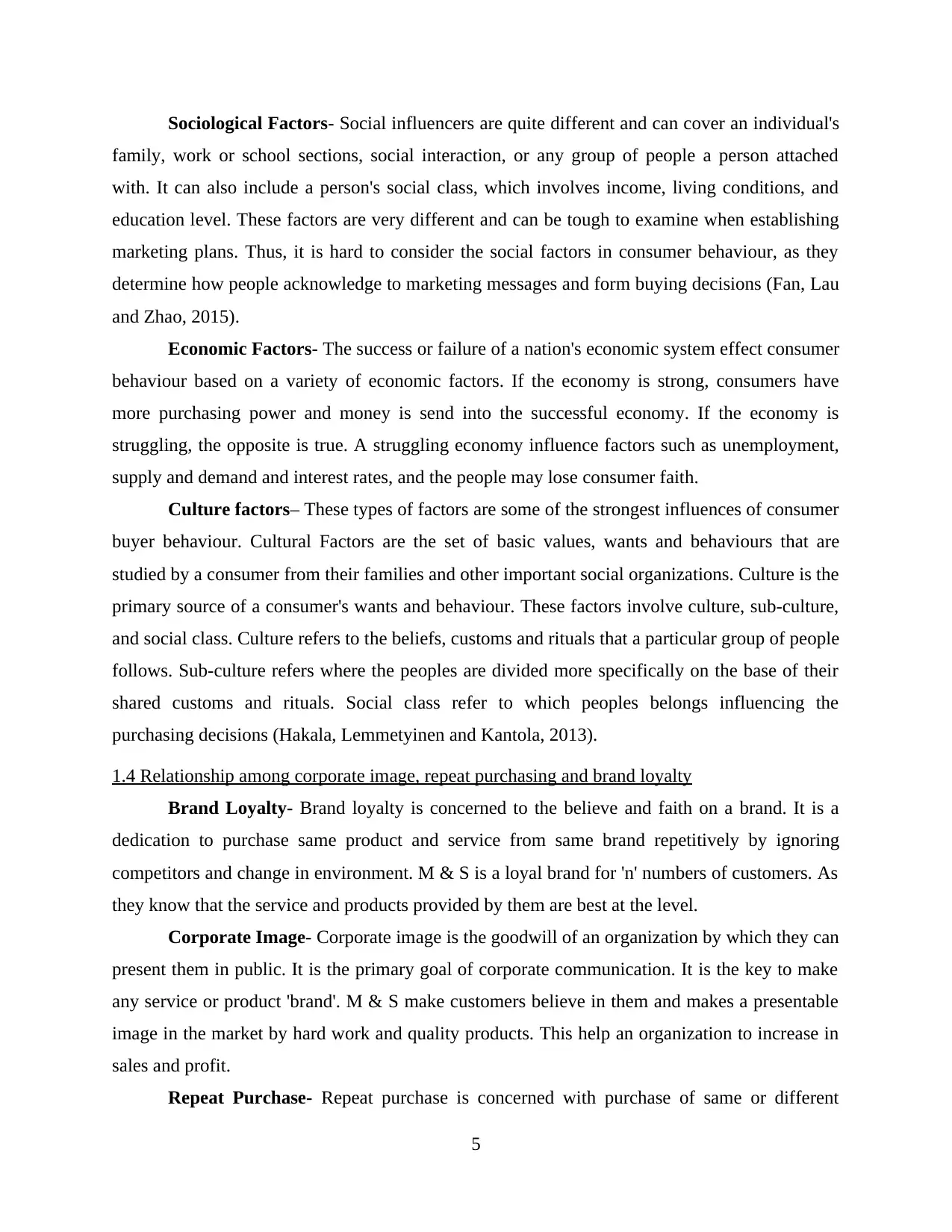
Sociological Factors- Social influencers are quite different and can cover an individual's
family, work or school sections, social interaction, or any group of people a person attached
with. It can also include a person's social class, which involves income, living conditions, and
education level. These factors are very different and can be tough to examine when establishing
marketing plans. Thus, it is hard to consider the social factors in consumer behaviour, as they
determine how people acknowledge to marketing messages and form buying decisions (Fan, Lau
and Zhao, 2015).
Economic Factors- The success or failure of a nation's economic system effect consumer
behaviour based on a variety of economic factors. If the economy is strong, consumers have
more purchasing power and money is send into the successful economy. If the economy is
struggling, the opposite is true. A struggling economy influence factors such as unemployment,
supply and demand and interest rates, and the people may lose consumer faith.
Culture factors– These types of factors are some of the strongest influences of consumer
buyer behaviour. Cultural Factors are the set of basic values, wants and behaviours that are
studied by a consumer from their families and other important social organizations. Culture is the
primary source of a consumer's wants and behaviour. These factors involve culture, sub-culture,
and social class. Culture refers to the beliefs, customs and rituals that a particular group of people
follows. Sub-culture refers where the peoples are divided more specifically on the base of their
shared customs and rituals. Social class refer to which peoples belongs influencing the
purchasing decisions (Hakala, Lemmetyinen and Kantola, 2013).
1.4 Relationship among corporate image, repeat purchasing and brand loyalty
Brand Loyalty- Brand loyalty is concerned to the believe and faith on a brand. It is a
dedication to purchase same product and service from same brand repetitively by ignoring
competitors and change in environment. M & S is a loyal brand for 'n' numbers of customers. As
they know that the service and products provided by them are best at the level.
Corporate Image- Corporate image is the goodwill of an organization by which they can
present them in public. It is the primary goal of corporate communication. It is the key to make
any service or product 'brand'. M & S make customers believe in them and makes a presentable
image in the market by hard work and quality products. This help an organization to increase in
sales and profit.
Repeat Purchase- Repeat purchase is concerned with purchase of same or different
5
family, work or school sections, social interaction, or any group of people a person attached
with. It can also include a person's social class, which involves income, living conditions, and
education level. These factors are very different and can be tough to examine when establishing
marketing plans. Thus, it is hard to consider the social factors in consumer behaviour, as they
determine how people acknowledge to marketing messages and form buying decisions (Fan, Lau
and Zhao, 2015).
Economic Factors- The success or failure of a nation's economic system effect consumer
behaviour based on a variety of economic factors. If the economy is strong, consumers have
more purchasing power and money is send into the successful economy. If the economy is
struggling, the opposite is true. A struggling economy influence factors such as unemployment,
supply and demand and interest rates, and the people may lose consumer faith.
Culture factors– These types of factors are some of the strongest influences of consumer
buyer behaviour. Cultural Factors are the set of basic values, wants and behaviours that are
studied by a consumer from their families and other important social organizations. Culture is the
primary source of a consumer's wants and behaviour. These factors involve culture, sub-culture,
and social class. Culture refers to the beliefs, customs and rituals that a particular group of people
follows. Sub-culture refers where the peoples are divided more specifically on the base of their
shared customs and rituals. Social class refer to which peoples belongs influencing the
purchasing decisions (Hakala, Lemmetyinen and Kantola, 2013).
1.4 Relationship among corporate image, repeat purchasing and brand loyalty
Brand Loyalty- Brand loyalty is concerned to the believe and faith on a brand. It is a
dedication to purchase same product and service from same brand repetitively by ignoring
competitors and change in environment. M & S is a loyal brand for 'n' numbers of customers. As
they know that the service and products provided by them are best at the level.
Corporate Image- Corporate image is the goodwill of an organization by which they can
present them in public. It is the primary goal of corporate communication. It is the key to make
any service or product 'brand'. M & S make customers believe in them and makes a presentable
image in the market by hard work and quality products. This help an organization to increase in
sales and profit.
Repeat Purchase- Repeat purchase is concerned with purchase of same or different
5
Paraphrase This Document
Need a fresh take? Get an instant paraphrase of this document with our AI Paraphraser
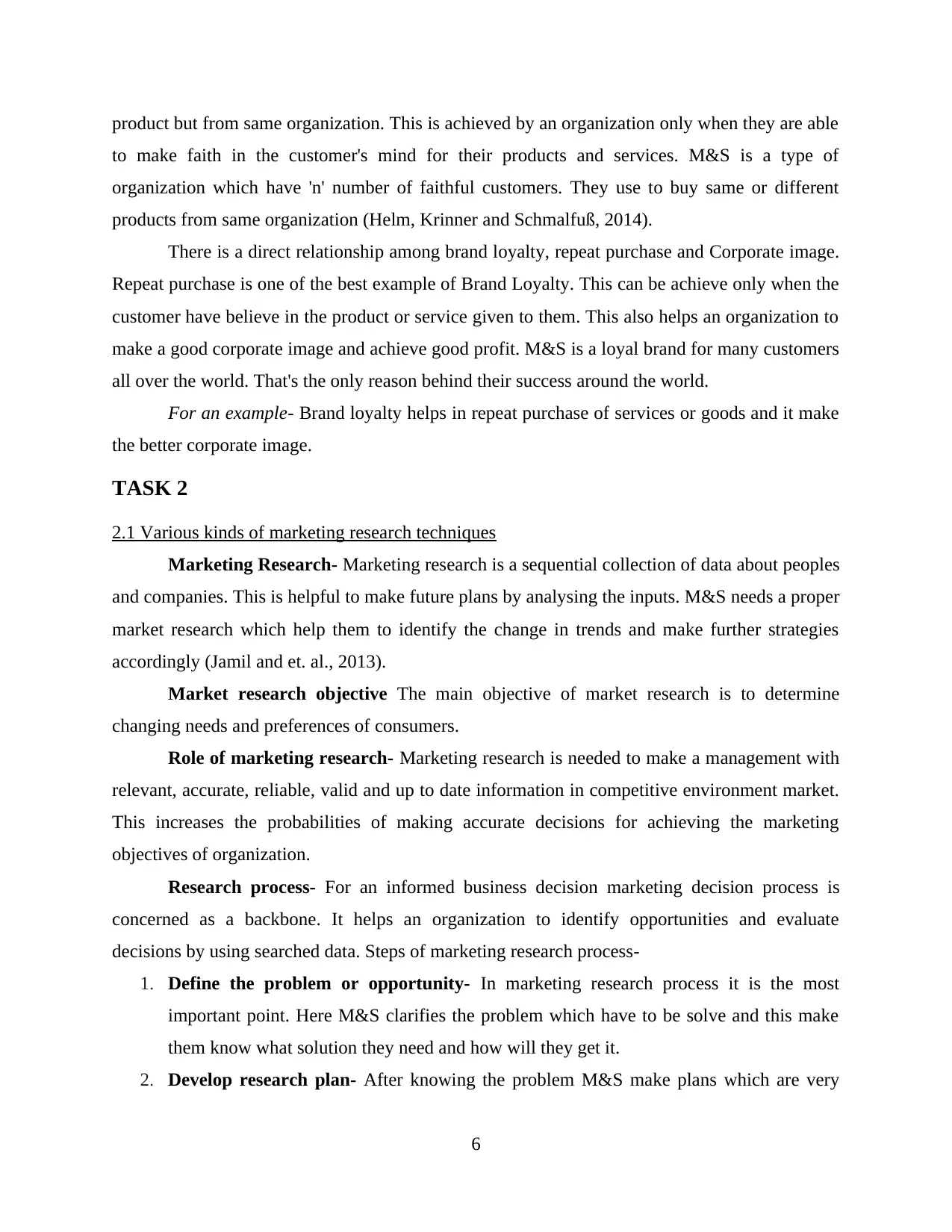
product but from same organization. This is achieved by an organization only when they are able
to make faith in the customer's mind for their products and services. M&S is a type of
organization which have 'n' number of faithful customers. They use to buy same or different
products from same organization (Helm, Krinner and Schmalfuß, 2014).
There is a direct relationship among brand loyalty, repeat purchase and Corporate image.
Repeat purchase is one of the best example of Brand Loyalty. This can be achieve only when the
customer have believe in the product or service given to them. This also helps an organization to
make a good corporate image and achieve good profit. M&S is a loyal brand for many customers
all over the world. That's the only reason behind their success around the world.
For an example- Brand loyalty helps in repeat purchase of services or goods and it make
the better corporate image.
TASK 2
2.1 Various kinds of marketing research techniques
Marketing Research- Marketing research is a sequential collection of data about peoples
and companies. This is helpful to make future plans by analysing the inputs. M&S needs a proper
market research which help them to identify the change in trends and make further strategies
accordingly (Jamil and et. al., 2013).
Market research objective The main objective of market research is to determine
changing needs and preferences of consumers.
Role of marketing research- Marketing research is needed to make a management with
relevant, accurate, reliable, valid and up to date information in competitive environment market.
This increases the probabilities of making accurate decisions for achieving the marketing
objectives of organization.
Research process- For an informed business decision marketing decision process is
concerned as a backbone. It helps an organization to identify opportunities and evaluate
decisions by using searched data. Steps of marketing research process-
1. Define the problem or opportunity- In marketing research process it is the most
important point. Here M&S clarifies the problem which have to be solve and this make
them know what solution they need and how will they get it.
2. Develop research plan- After knowing the problem M&S make plans which are very
6
to make faith in the customer's mind for their products and services. M&S is a type of
organization which have 'n' number of faithful customers. They use to buy same or different
products from same organization (Helm, Krinner and Schmalfuß, 2014).
There is a direct relationship among brand loyalty, repeat purchase and Corporate image.
Repeat purchase is one of the best example of Brand Loyalty. This can be achieve only when the
customer have believe in the product or service given to them. This also helps an organization to
make a good corporate image and achieve good profit. M&S is a loyal brand for many customers
all over the world. That's the only reason behind their success around the world.
For an example- Brand loyalty helps in repeat purchase of services or goods and it make
the better corporate image.
TASK 2
2.1 Various kinds of marketing research techniques
Marketing Research- Marketing research is a sequential collection of data about peoples
and companies. This is helpful to make future plans by analysing the inputs. M&S needs a proper
market research which help them to identify the change in trends and make further strategies
accordingly (Jamil and et. al., 2013).
Market research objective The main objective of market research is to determine
changing needs and preferences of consumers.
Role of marketing research- Marketing research is needed to make a management with
relevant, accurate, reliable, valid and up to date information in competitive environment market.
This increases the probabilities of making accurate decisions for achieving the marketing
objectives of organization.
Research process- For an informed business decision marketing decision process is
concerned as a backbone. It helps an organization to identify opportunities and evaluate
decisions by using searched data. Steps of marketing research process-
1. Define the problem or opportunity- In marketing research process it is the most
important point. Here M&S clarifies the problem which have to be solve and this make
them know what solution they need and how will they get it.
2. Develop research plan- After knowing the problem M&S make plans which are very
6
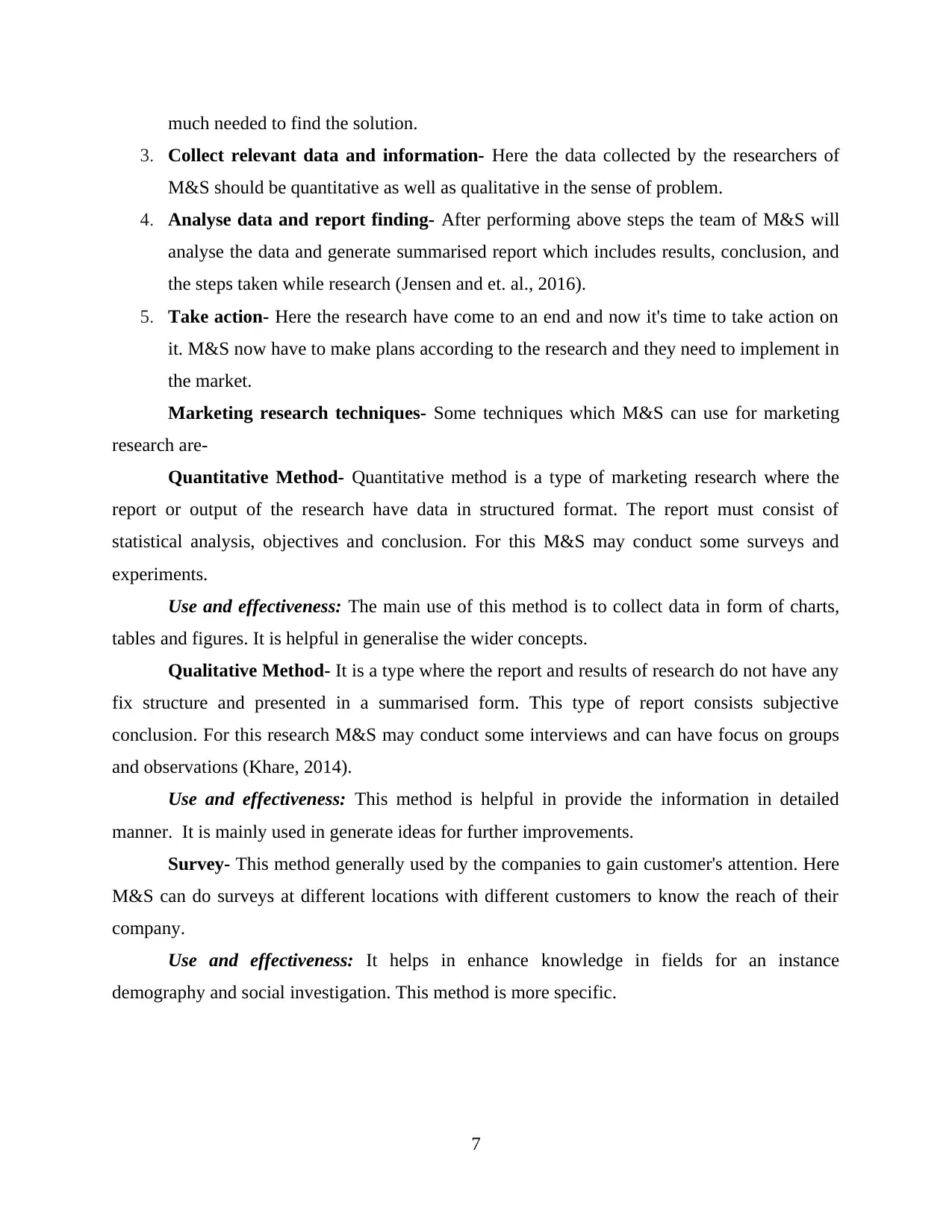
much needed to find the solution.
3. Collect relevant data and information- Here the data collected by the researchers of
M&S should be quantitative as well as qualitative in the sense of problem.
4. Analyse data and report finding- After performing above steps the team of M&S will
analyse the data and generate summarised report which includes results, conclusion, and
the steps taken while research (Jensen and et. al., 2016).
5. Take action- Here the research have come to an end and now it's time to take action on
it. M&S now have to make plans according to the research and they need to implement in
the market.
Marketing research techniques- Some techniques which M&S can use for marketing
research are-
Quantitative Method- Quantitative method is a type of marketing research where the
report or output of the research have data in structured format. The report must consist of
statistical analysis, objectives and conclusion. For this M&S may conduct some surveys and
experiments.
Use and effectiveness: The main use of this method is to collect data in form of charts,
tables and figures. It is helpful in generalise the wider concepts.
Qualitative Method- It is a type where the report and results of research do not have any
fix structure and presented in a summarised form. This type of report consists subjective
conclusion. For this research M&S may conduct some interviews and can have focus on groups
and observations (Khare, 2014).
Use and effectiveness: This method is helpful in provide the information in detailed
manner. It is mainly used in generate ideas for further improvements.
Survey- This method generally used by the companies to gain customer's attention. Here
M&S can do surveys at different locations with different customers to know the reach of their
company.
Use and effectiveness: It helps in enhance knowledge in fields for an instance
demography and social investigation. This method is more specific.
7
3. Collect relevant data and information- Here the data collected by the researchers of
M&S should be quantitative as well as qualitative in the sense of problem.
4. Analyse data and report finding- After performing above steps the team of M&S will
analyse the data and generate summarised report which includes results, conclusion, and
the steps taken while research (Jensen and et. al., 2016).
5. Take action- Here the research have come to an end and now it's time to take action on
it. M&S now have to make plans according to the research and they need to implement in
the market.
Marketing research techniques- Some techniques which M&S can use for marketing
research are-
Quantitative Method- Quantitative method is a type of marketing research where the
report or output of the research have data in structured format. The report must consist of
statistical analysis, objectives and conclusion. For this M&S may conduct some surveys and
experiments.
Use and effectiveness: The main use of this method is to collect data in form of charts,
tables and figures. It is helpful in generalise the wider concepts.
Qualitative Method- It is a type where the report and results of research do not have any
fix structure and presented in a summarised form. This type of report consists subjective
conclusion. For this research M&S may conduct some interviews and can have focus on groups
and observations (Khare, 2014).
Use and effectiveness: This method is helpful in provide the information in detailed
manner. It is mainly used in generate ideas for further improvements.
Survey- This method generally used by the companies to gain customer's attention. Here
M&S can do surveys at different locations with different customers to know the reach of their
company.
Use and effectiveness: It helps in enhance knowledge in fields for an instance
demography and social investigation. This method is more specific.
7
⊘ This is a preview!⊘
Do you want full access?
Subscribe today to unlock all pages.

Trusted by 1+ million students worldwide
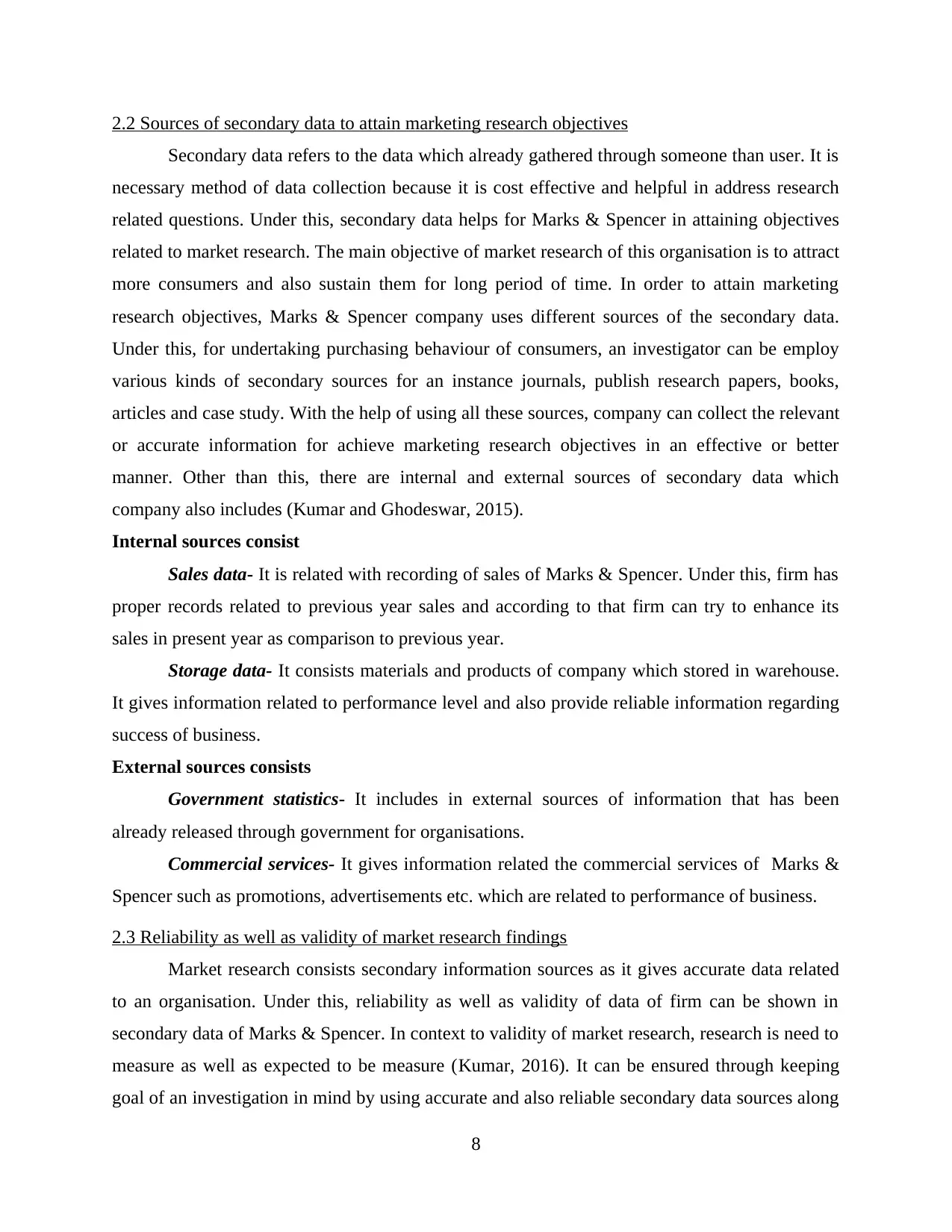
2.2 Sources of secondary data to attain marketing research objectives
Secondary data refers to the data which already gathered through someone than user. It is
necessary method of data collection because it is cost effective and helpful in address research
related questions. Under this, secondary data helps for Marks & Spencer in attaining objectives
related to market research. The main objective of market research of this organisation is to attract
more consumers and also sustain them for long period of time. In order to attain marketing
research objectives, Marks & Spencer company uses different sources of the secondary data.
Under this, for undertaking purchasing behaviour of consumers, an investigator can be employ
various kinds of secondary sources for an instance journals, publish research papers, books,
articles and case study. With the help of using all these sources, company can collect the relevant
or accurate information for achieve marketing research objectives in an effective or better
manner. Other than this, there are internal and external sources of secondary data which
company also includes (Kumar and Ghodeswar, 2015).
Internal sources consist
Sales data- It is related with recording of sales of Marks & Spencer. Under this, firm has
proper records related to previous year sales and according to that firm can try to enhance its
sales in present year as comparison to previous year.
Storage data- It consists materials and products of company which stored in warehouse.
It gives information related to performance level and also provide reliable information regarding
success of business.
External sources consists
Government statistics- It includes in external sources of information that has been
already released through government for organisations.
Commercial services- It gives information related the commercial services of Marks &
Spencer such as promotions, advertisements etc. which are related to performance of business.
2.3 Reliability as well as validity of market research findings
Market research consists secondary information sources as it gives accurate data related
to an organisation. Under this, reliability as well as validity of data of firm can be shown in
secondary data of Marks & Spencer. In context to validity of market research, research is need to
measure as well as expected to be measure (Kumar, 2016). It can be ensured through keeping
goal of an investigation in mind by using accurate and also reliable secondary data sources along
8
Secondary data refers to the data which already gathered through someone than user. It is
necessary method of data collection because it is cost effective and helpful in address research
related questions. Under this, secondary data helps for Marks & Spencer in attaining objectives
related to market research. The main objective of market research of this organisation is to attract
more consumers and also sustain them for long period of time. In order to attain marketing
research objectives, Marks & Spencer company uses different sources of the secondary data.
Under this, for undertaking purchasing behaviour of consumers, an investigator can be employ
various kinds of secondary sources for an instance journals, publish research papers, books,
articles and case study. With the help of using all these sources, company can collect the relevant
or accurate information for achieve marketing research objectives in an effective or better
manner. Other than this, there are internal and external sources of secondary data which
company also includes (Kumar and Ghodeswar, 2015).
Internal sources consist
Sales data- It is related with recording of sales of Marks & Spencer. Under this, firm has
proper records related to previous year sales and according to that firm can try to enhance its
sales in present year as comparison to previous year.
Storage data- It consists materials and products of company which stored in warehouse.
It gives information related to performance level and also provide reliable information regarding
success of business.
External sources consists
Government statistics- It includes in external sources of information that has been
already released through government for organisations.
Commercial services- It gives information related the commercial services of Marks &
Spencer such as promotions, advertisements etc. which are related to performance of business.
2.3 Reliability as well as validity of market research findings
Market research consists secondary information sources as it gives accurate data related
to an organisation. Under this, reliability as well as validity of data of firm can be shown in
secondary data of Marks & Spencer. In context to validity of market research, research is need to
measure as well as expected to be measure (Kumar, 2016). It can be ensured through keeping
goal of an investigation in mind by using accurate and also reliable secondary data sources along
8
Paraphrase This Document
Need a fresh take? Get an instant paraphrase of this document with our AI Paraphraser
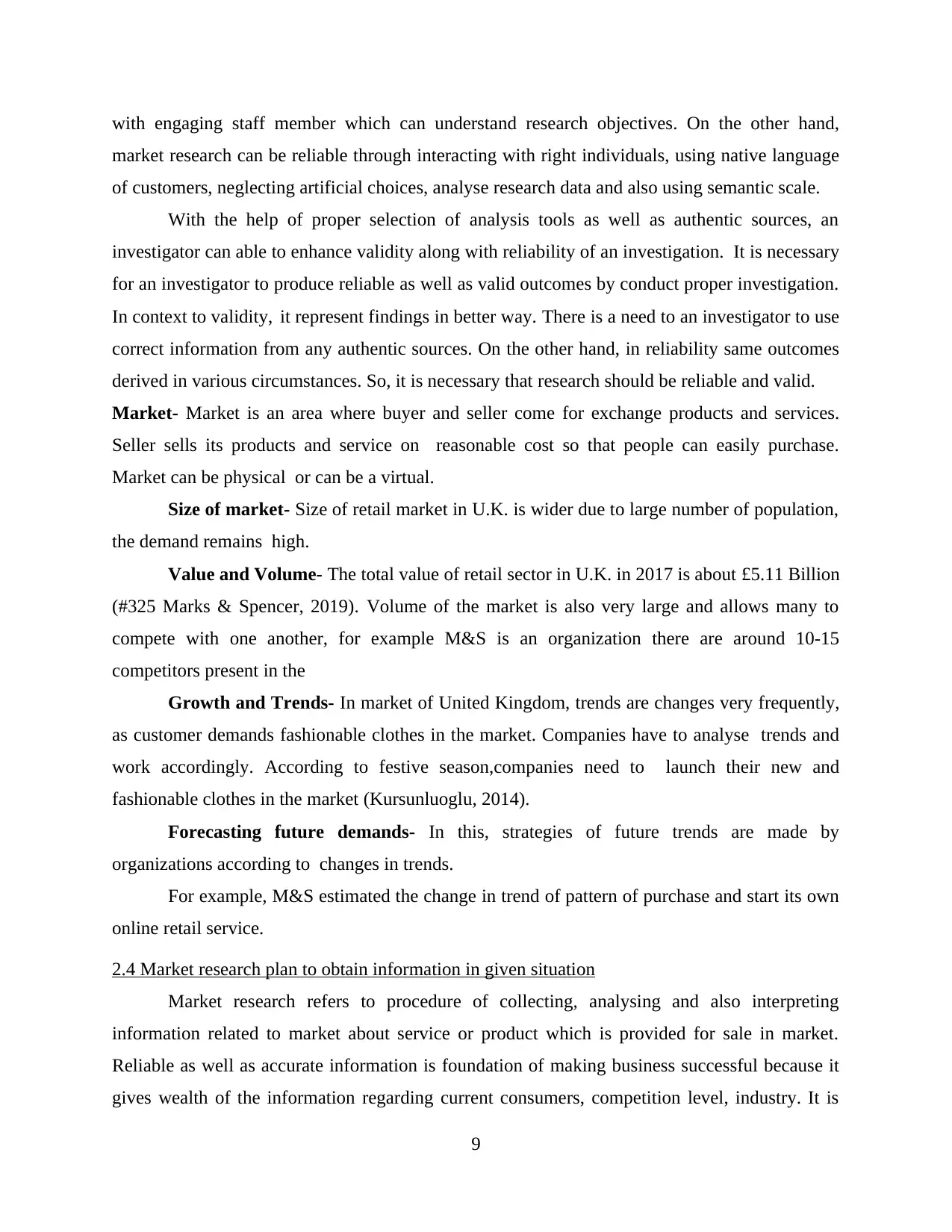
with engaging staff member which can understand research objectives. On the other hand,
market research can be reliable through interacting with right individuals, using native language
of customers, neglecting artificial choices, analyse research data and also using semantic scale.
With the help of proper selection of analysis tools as well as authentic sources, an
investigator can able to enhance validity along with reliability of an investigation. It is necessary
for an investigator to produce reliable as well as valid outcomes by conduct proper investigation.
In context to validity, it represent findings in better way. There is a need to an investigator to use
correct information from any authentic sources. On the other hand, in reliability same outcomes
derived in various circumstances. So, it is necessary that research should be reliable and valid.
Market- Market is an area where buyer and seller come for exchange products and services.
Seller sells its products and service on reasonable cost so that people can easily purchase.
Market can be physical or can be a virtual.
Size of market- Size of retail market in U.K. is wider due to large number of population,
the demand remains high.
Value and Volume- The total value of retail sector in U.K. in 2017 is about £5.11 Billion
(#325 Marks & Spencer, 2019). Volume of the market is also very large and allows many to
compete with one another, for example M&S is an organization there are around 10-15
competitors present in the
Growth and Trends- In market of United Kingdom, trends are changes very frequently,
as customer demands fashionable clothes in the market. Companies have to analyse trends and
work accordingly. According to festive season,companies need to launch their new and
fashionable clothes in the market (Kursunluoglu, 2014).
Forecasting future demands- In this, strategies of future trends are made by
organizations according to changes in trends.
For example, M&S estimated the change in trend of pattern of purchase and start its own
online retail service.
2.4 Market research plan to obtain information in given situation
Market research refers to procedure of collecting, analysing and also interpreting
information related to market about service or product which is provided for sale in market.
Reliable as well as accurate information is foundation of making business successful because it
gives wealth of the information regarding current consumers, competition level, industry. It is
9
market research can be reliable through interacting with right individuals, using native language
of customers, neglecting artificial choices, analyse research data and also using semantic scale.
With the help of proper selection of analysis tools as well as authentic sources, an
investigator can able to enhance validity along with reliability of an investigation. It is necessary
for an investigator to produce reliable as well as valid outcomes by conduct proper investigation.
In context to validity, it represent findings in better way. There is a need to an investigator to use
correct information from any authentic sources. On the other hand, in reliability same outcomes
derived in various circumstances. So, it is necessary that research should be reliable and valid.
Market- Market is an area where buyer and seller come for exchange products and services.
Seller sells its products and service on reasonable cost so that people can easily purchase.
Market can be physical or can be a virtual.
Size of market- Size of retail market in U.K. is wider due to large number of population,
the demand remains high.
Value and Volume- The total value of retail sector in U.K. in 2017 is about £5.11 Billion
(#325 Marks & Spencer, 2019). Volume of the market is also very large and allows many to
compete with one another, for example M&S is an organization there are around 10-15
competitors present in the
Growth and Trends- In market of United Kingdom, trends are changes very frequently,
as customer demands fashionable clothes in the market. Companies have to analyse trends and
work accordingly. According to festive season,companies need to launch their new and
fashionable clothes in the market (Kursunluoglu, 2014).
Forecasting future demands- In this, strategies of future trends are made by
organizations according to changes in trends.
For example, M&S estimated the change in trend of pattern of purchase and start its own
online retail service.
2.4 Market research plan to obtain information in given situation
Market research refers to procedure of collecting, analysing and also interpreting
information related to market about service or product which is provided for sale in market.
Reliable as well as accurate information is foundation of making business successful because it
gives wealth of the information regarding current consumers, competition level, industry. It is
9
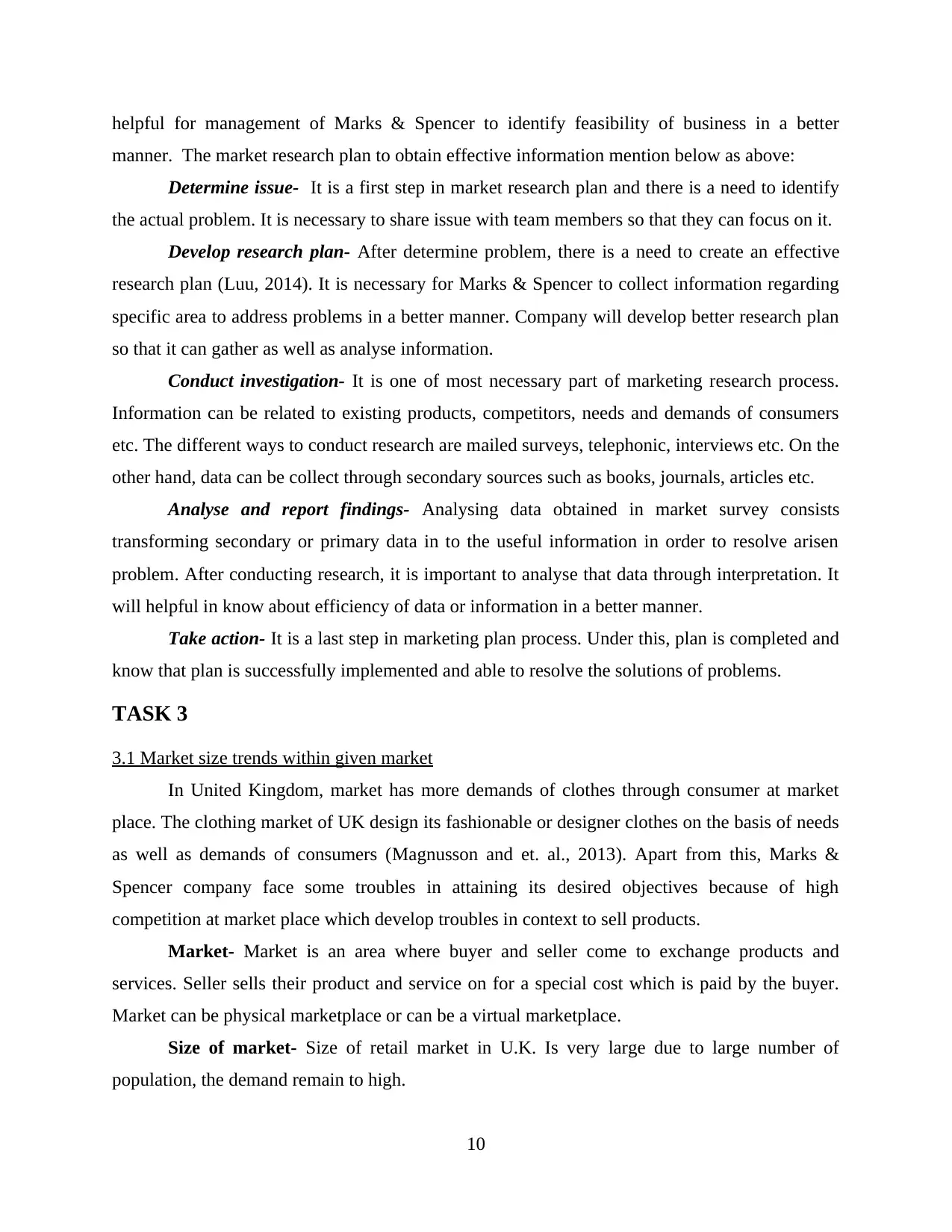
helpful for management of Marks & Spencer to identify feasibility of business in a better
manner. The market research plan to obtain effective information mention below as above:
Determine issue- It is a first step in market research plan and there is a need to identify
the actual problem. It is necessary to share issue with team members so that they can focus on it.
Develop research plan- After determine problem, there is a need to create an effective
research plan (Luu, 2014). It is necessary for Marks & Spencer to collect information regarding
specific area to address problems in a better manner. Company will develop better research plan
so that it can gather as well as analyse information.
Conduct investigation- It is one of most necessary part of marketing research process.
Information can be related to existing products, competitors, needs and demands of consumers
etc. The different ways to conduct research are mailed surveys, telephonic, interviews etc. On the
other hand, data can be collect through secondary sources such as books, journals, articles etc.
Analyse and report findings- Analysing data obtained in market survey consists
transforming secondary or primary data in to the useful information in order to resolve arisen
problem. After conducting research, it is important to analyse that data through interpretation. It
will helpful in know about efficiency of data or information in a better manner.
Take action- It is a last step in marketing plan process. Under this, plan is completed and
know that plan is successfully implemented and able to resolve the solutions of problems.
TASK 3
3.1 Market size trends within given market
In United Kingdom, market has more demands of clothes through consumer at market
place. The clothing market of UK design its fashionable or designer clothes on the basis of needs
as well as demands of consumers (Magnusson and et. al., 2013). Apart from this, Marks &
Spencer company face some troubles in attaining its desired objectives because of high
competition at market place which develop troubles in context to sell products.
Market- Market is an area where buyer and seller come to exchange products and
services. Seller sells their product and service on for a special cost which is paid by the buyer.
Market can be physical marketplace or can be a virtual marketplace.
Size of market- Size of retail market in U.K. Is very large due to large number of
population, the demand remain to high.
10
manner. The market research plan to obtain effective information mention below as above:
Determine issue- It is a first step in market research plan and there is a need to identify
the actual problem. It is necessary to share issue with team members so that they can focus on it.
Develop research plan- After determine problem, there is a need to create an effective
research plan (Luu, 2014). It is necessary for Marks & Spencer to collect information regarding
specific area to address problems in a better manner. Company will develop better research plan
so that it can gather as well as analyse information.
Conduct investigation- It is one of most necessary part of marketing research process.
Information can be related to existing products, competitors, needs and demands of consumers
etc. The different ways to conduct research are mailed surveys, telephonic, interviews etc. On the
other hand, data can be collect through secondary sources such as books, journals, articles etc.
Analyse and report findings- Analysing data obtained in market survey consists
transforming secondary or primary data in to the useful information in order to resolve arisen
problem. After conducting research, it is important to analyse that data through interpretation. It
will helpful in know about efficiency of data or information in a better manner.
Take action- It is a last step in marketing plan process. Under this, plan is completed and
know that plan is successfully implemented and able to resolve the solutions of problems.
TASK 3
3.1 Market size trends within given market
In United Kingdom, market has more demands of clothes through consumer at market
place. The clothing market of UK design its fashionable or designer clothes on the basis of needs
as well as demands of consumers (Magnusson and et. al., 2013). Apart from this, Marks &
Spencer company face some troubles in attaining its desired objectives because of high
competition at market place which develop troubles in context to sell products.
Market- Market is an area where buyer and seller come to exchange products and
services. Seller sells their product and service on for a special cost which is paid by the buyer.
Market can be physical marketplace or can be a virtual marketplace.
Size of market- Size of retail market in U.K. Is very large due to large number of
population, the demand remain to high.
10
⊘ This is a preview!⊘
Do you want full access?
Subscribe today to unlock all pages.

Trusted by 1+ million students worldwide
1 out of 19
Related Documents
Your All-in-One AI-Powered Toolkit for Academic Success.
+13062052269
info@desklib.com
Available 24*7 on WhatsApp / Email
![[object Object]](/_next/static/media/star-bottom.7253800d.svg)
Unlock your academic potential
Copyright © 2020–2025 A2Z Services. All Rights Reserved. Developed and managed by ZUCOL.





